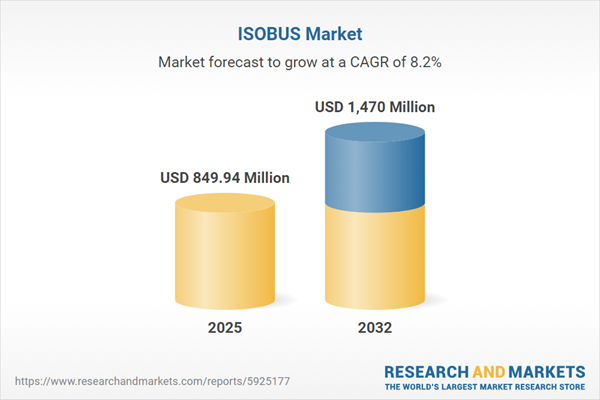Speak directly to the analyst to clarify any post sales queries you may have.
ISOBUS technology is empowering agricultural enterprises to drive operational efficiency and sustainability, supporting digitally connected machinery and streamlined field management aligned with the evolving needs of modern agriculture.
Market Snapshot: ISOBUS Market Size & Growth Drivers
The ISOBUS market is projected to grow from USD 784.59 million in 2024 to USD 849.94 million in 2025, reaching an estimated USD 1.47 billion by 2032, representing a compound annual growth rate of 8.22%.
Key market growth drivers include accelerated digital transformation investments, increased implementation of interoperability standards, and the modernization of farming operations globally. Industry participants are shifting toward harmonized technology ecosystems and modular system designs, supporting more dynamic and integrated agricultural networks. This evolution enables modern farming organizations to optimize resource allocation, support data-driven decisions, and maximize productivity amid shifting regulatory and operational demands.Scope & Segmentation: ISOBUS Market
- Product Types: Electric actuators, hydraulic actuators, pneumatic actuators, auto steering units, auxiliary and section control units, multifunctional and basic display terminals, position sensors, pressure sensors, and temperature sensors. Together, these components underpin automation, enable advanced asset tracking, and support the precise capture of real-time field data.
- Equipment Types: Round and square balers, combine and forage harvesters, self-propelled and trailed sprayers, and a broad range of tractor categories, including row crop, specialty, and utility models. This equipment array supports operational versatility and scalability for diverse field tasks and changing production goals.
- Applications: Fertilizing, harvesting, planting, livestock feeding, operator guidance, variable rate crop application, yield mapping, soil moisture tracking, nutrient monitoring, and crop health diagnostics. These uses enhance precision agriculture by improving field management and delivering actionable insights for every stage of the production lifecycle.
- End Users: Regional distributors, retailers, agricultural cooperatives, farm enterprises, original equipment manufacturers, consultants, and maintenance providers. Each plays a specific role in promoting ISOBUS adoption, supporting ongoing service, and advancing sector innovation and reliability.
- Transmission Modes: CAN Bus, Ethernet, Bluetooth, cellular, and Wi-Fi technologies ensure reliable, high-speed communication and seamless integration, allowing compatibility across equipment brands and legacy systems.
- Regions: North America, Latin America, Europe, Middle East, Africa, and Asia-Pacific. Regional adoption patterns reflect differences in regulatory approaches, investment priorities, and the pace of technology modernization.
For enterprises, adopting integrated ISOBUS systems means enhanced real-time data management and centralized equipment control. Retrofit solutions extend digital connectivity to existing assets, allowing organizations to leverage the full value of their current machinery while advancing operational sustainability initiatives.
Key Takeaways: Strategic Insights for ISOBUS Market Leaders
- Standardized ISOBUS implementation enables end-to-end precision farming, connecting advanced digital systems with increasingly sophisticated machinery for improved operational unity.
- Effective interoperable communication accelerates automation, making field processes more agile and capable of adapting to changing requirements without significant manual intervention.
- Routine remote diagnostics and ongoing equipment calibration enhance asset reliability, allowing quick responses to evolving field conditions and supporting business continuity.
- Regional market dynamics influence organizational priorities: North America focuses on digital infrastructure scalability; Europe drives regulatory harmonization and interoperability; Asia-Pacific advances rapid technology upgrades and connectivity adoption.
- Active collaboration among key stakeholders, including equipment manufacturers, producers, and regulatory bodies, fosters the development of innovative technology solutions that meet current and future industry standards.
- Unified digital operations and targeted system upgrades help organizations sustain strong supply chains and adapt confidently to regulatory or market fluctuations.
Tariff Impact: Navigating U.S. Trade Policy
With scheduled U.S. tariffs for 2025, ISOBUS market participants are reevaluating supply chain models to address new procurement risks. Manufacturers are expanding supplier relationships, optimizing inventory strategies, and enhancing risk frameworks to ensure resilience. Dealers and enterprise operators are adjusting their cost management and continuity strategies, maintaining stability despite shifts in the broader trade environment.
Methodology & Data Sources
This analysis integrates perspectives from original equipment manufacturers, expert sources, and enterprise farm operators, verified through industry telemetry and ISO standard documentation. The result is actionable intelligence designed to support executive decisions within agricultural technology.
Why This Report Matters
- Supports leadership teams in accelerating digital transformation, improving system interoperability, and scaling operational modernization across agricultural enterprises.
- Enables organizations to strengthen supply chain resilience and adapt quickly to changes in regulatory requirements or market dynamics.
- Provides insight-driven guidance for strategic investment, helping businesses transition toward more efficient and sustainable agricultural models.
Conclusion
ISOBUS solutions position organizations to achieve digital unification and operational agility, meeting the challenges of a rapidly advancing agricultural technology market. Leveraging these insights enables confident enterprise transformation and supports sustained competitive growth.
Additional Product Information:
- Purchase of this report includes 1 year online access with quarterly updates.
- This report can be updated on request. Please contact our Customer Experience team using the Ask a Question widget on our website.
Table of Contents
3. Executive Summary
4. Market Overview
7. Cumulative Impact of Artificial Intelligence 2025
Companies Mentioned
The companies profiled in this ISOBUS market report include:- Deere & Company
- CNH Industrial N.V.
- AGCO Corporation
- Trimble Inc.
- Topcon Corporation
- Hexagon AB
- CLAAS KGaA mbH
- Kubota Corporation
- Yanmar Holdings Co., Ltd.
- Bosch Rexroth AG
Table Information
| Report Attribute | Details |
|---|---|
| No. of Pages | 182 |
| Published | November 2025 |
| Forecast Period | 2025 - 2032 |
| Estimated Market Value ( USD | $ 849.94 Million |
| Forecasted Market Value ( USD | $ 1470 Million |
| Compound Annual Growth Rate | 8.2% |
| Regions Covered | Global |
| No. of Companies Mentioned | 11 |









